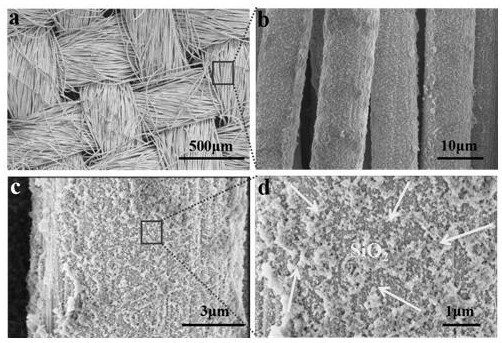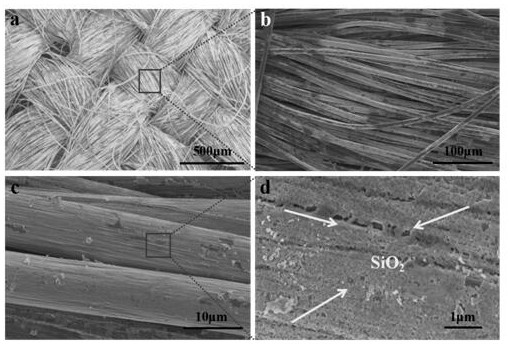A self-standing adhesive-free flexible sio 2 Preparation methods and applications of @c composite materials
A self-supporting, negative electrode material technology, applied in the direction of structural parts, active material electrodes, electrical components, etc., to achieve the effect of easy electron transmission, small size, and good crystallinity
- Summary
- Abstract
- Description
- Claims
- Application Information
AI Technical Summary
Problems solved by technology
Method used
Image
Examples
preparation example Construction
[0018] The invention provides a free-standing flexible SiO without binder 2 The preparation method and application of the @C composite material, including the following steps:
[0019] S1. Acidizing treatment of carbon cloth;
[0020] The carbon cloth was pretreated, and the carbon cloth was cut into cubes of 3cm×3cm×0.1cm, soaked in a hydrochloric acid solution with a concentration of 1mol / L for 12 hours, and then washed alternately with deionized water and ethanol for 3 times at 60°C. Drying to obtain acidified carbon cloth A;
[0021] S2, the preparation of precursor solution;
[0022] Mix 0.1~0.5mL ethyl orthosilicate (TEOS) with 10~60ml deionized water, and stir for 1~2 hours to obtain solution B; mix solution B with 0.05~0.2ml 25% ammonia water and stir for 1~ Solution C was obtained after 2 hours;
[0023] S3. Free-standing flexible SiO without binder 2 Preparation of @C Composites
[0024] Put the carbon cloth A and the solution C into the reaction kettle togethe...
Embodiment 1
[0031] S1. Acidizing treatment of carbon cloth;
[0032] The carbon cloth was pretreated, and the carbon cloth was cut into cubes of 3cm × 3cm × 0.1cm, soaked in a hydrochloric acid solution with a concentration of 1mol / L for 12 hours, and then washed with deionized water and ethanol alternately for 3 times at 60°C. After drying, acidified carbon cloth A is obtained;
[0033] S2, the preparation of precursor solution;
[0034] Mix 0.1 mL of tetraethyl orthosilicate (TEOS) and 10 mL of deionized water, and stir for 1 hour to obtain solution B; mix solution B with 0.05 mL of 25% ammonia water and stir for 1 hour to obtain solution C;
[0035] S3. Free-standing flexible SiO without binder 2 Preparation of @C Composites
[0036] Put the carbon cloth A and the solution C into the reactor together, and react at 180 ° C for 10 hours; after the reaction, take out the carbon cloth, wash it with water and alcohol three times, and then dry it at 80 ° C to obtain a self-supporting non-...
Embodiment 2
[0042] S1. Acidizing treatment of carbon cloth;
[0043]The carbon cloth was pretreated, and the carbon cloth was cut into cubes of 3cm × 3cm × 0.1cm, soaked in a hydrochloric acid solution with a concentration of 1mol / L for 12 hours, and then washed with deionized water and ethanol alternately for 3 times at 60°C. After drying, acidified carbon cloth A is obtained;
[0044] S2, the preparation of precursor solution;
[0045] Mix 0.53 mL of tetraethyl orthosilicate (TEOS) and 40 mL of deionized water, and stir for 2 hours to obtain solution B; mix solution B with 0.15 mL of 25% ammonia, and stir for 1 hour to obtain solution C;
[0046] S3. Free-standing flexible SiO without binder 2 Preparation of @C Composites
[0047] Put the carbon cloth A and the solution C into the reaction kettle together, and react at 200 ° C for 10 hours; after the reaction, take out the carbon cloth, wash it with water and alcohol three times, and then dry it at 80 ° C to obtain a self-supporting ...
PUM
 Login to View More
Login to View More Abstract
Description
Claims
Application Information
 Login to View More
Login to View More - R&D
- Intellectual Property
- Life Sciences
- Materials
- Tech Scout
- Unparalleled Data Quality
- Higher Quality Content
- 60% Fewer Hallucinations
Browse by: Latest US Patents, China's latest patents, Technical Efficacy Thesaurus, Application Domain, Technology Topic, Popular Technical Reports.
© 2025 PatSnap. All rights reserved.Legal|Privacy policy|Modern Slavery Act Transparency Statement|Sitemap|About US| Contact US: help@patsnap.com



